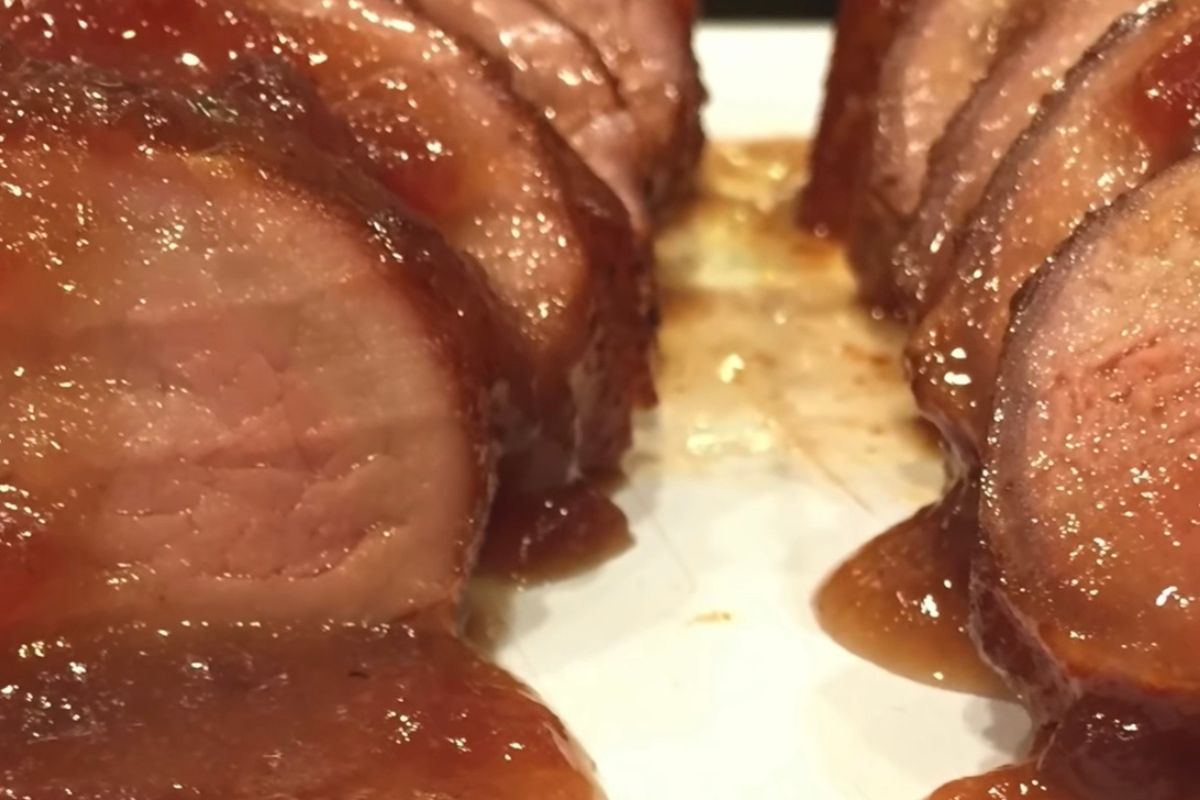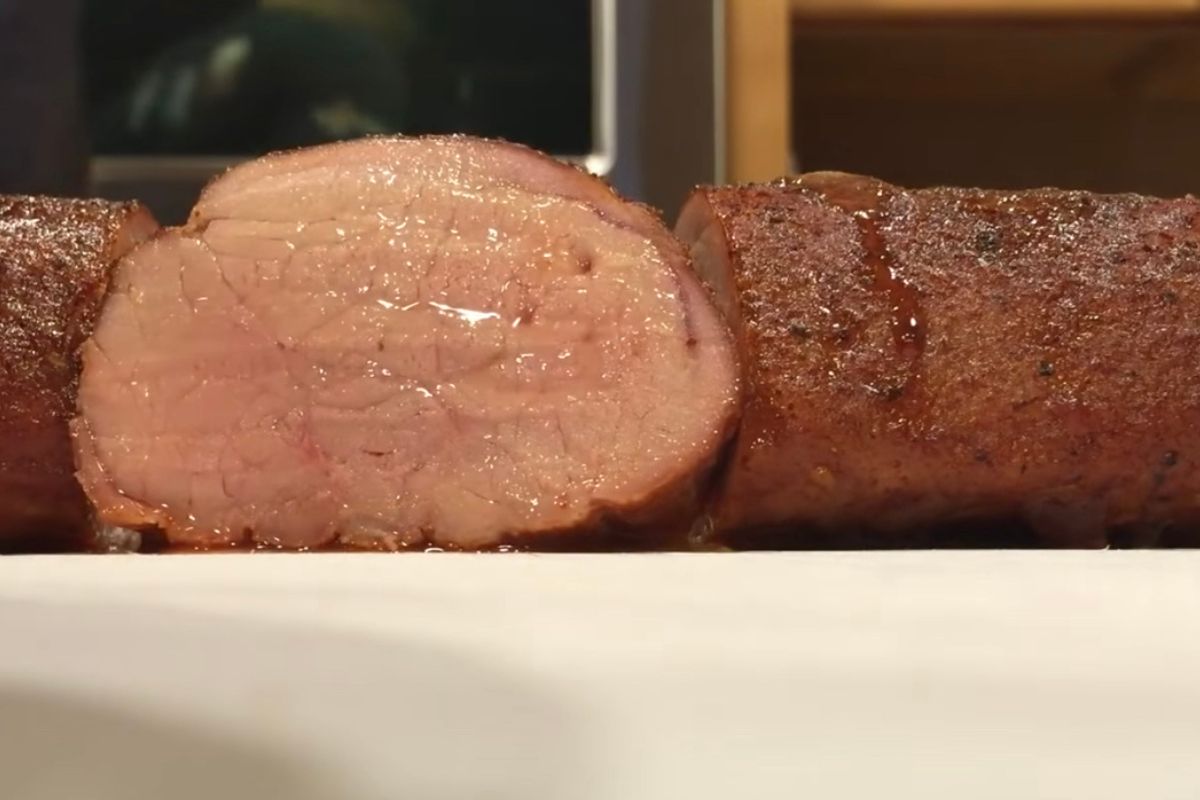For a lot of Americans, the idea of returning home from a hard day’s work and eating a delicious, tender and juicy pork tenderloin is incredibly welcome! It’s been one of the most go-to dinner choices for years.
It’s tasty, it fills your belly and is very versatile with meal choices. Additionally, it provides an ideal option for leftovers and that is worth its weight in gold.

We all know it’s important to ensure your food is cooked properly and this is perhaps more crucial when we’re deciding to cook up a pork tenderloin.
This guide will examine the best possible way you can prepare your pork, cook it in the best way and how hot it should be for a safe temperature.
So, take a seat and get yourself comfortable as we look at pork tenderloins in all their glory!
The Basics
When it comes to safely cooking pork, we need to look at the guidelines set out by the USDA. They tell us that the safe internal temperature for pork tenderloin needs to be 145 degrees Fahrenheit. The thing is, it’s not exactly that simple.
Before you go out with your heat thermometer and look for that mark, you need to ask yourself a whole host of questions which can change the result of your ideal temperature.
What is the cooking method? Are you planning to fry, grill, smoke, or oven-cook the tenderloin? Maybe you’re planning to use multiple methods? What about marinating?
You might not think that these questions matter so much as long as you’re hitting that temperature measurement, but that’s not true.
The fact is, the method that you’re cooking your tenderloin and all of its variables can change the temperature that you’ll want to be hitting.
What’s more, there’s an argument for not even hitting the 145 degrees Fahrenheit. You could take the pork out at 135 degrees Fahrenheit instead and still get some fantastic tenderloins.
So, Is It Safe To Eat Pork At 145 Degrees Fahrenheit Then?
As a rule of thumb, yes. As this is the USDA guidelines, you can be sure that they have done their homework and scientifically explored this to keep American citizens safe when they’re making their evening dinner!
The USDA regularly reviews their guidelines and ensures they are always providing us with the most up to date and accurate cooking information.
Back in 2011, the USDA altered their advice of cooking pork to 160 degrees Fahrenheit and made that 145 degrees Fahrenheit, with an inclusion of a 3 minute “settle” period.
That 3-minute settle period or rest time is important because if there are any minute pathogens remaining on the meat, this little extra time will ensure they’re being cooked off.
However, these guidelines do not apply to ground pork. Ground pork still needs to be cooked to the original advice of 160 degrees Fahrenheit to make sure of food safety.
When talking about time and temperature, it’s essential that we note why these guidelines exist. The guideline cooking temperature refers to the heat measurements when pathogens that exist and breed on certain food types are eradicated.
With pork, certain pathogens are common, and the temperature required is 160 degrees Fahrenheit for ground pork and 145 degrees Fahrenheit for most other cuts of pork.
As we cook food in different ways, the settle period is essential because the pathogens will be eradicated after spending an extra 3 minutes in the oven at the lower temperature.
If we had a cooking machine that instantly heated pork to 145 degrees Fahrenheit – the pathogens would be eradicated, but the tenderloins would likely be crispy and solid!
On the flip side, if you were to cook your pork to a temperature of 140 degrees Fahrenheit, you’d need to let it settle for an extra 1 minute to ensure pathogens are cooked off.
What Temperature Should You Cook Tenderloins At?
Before we get into that, we need to remember that pork tenderloins are a very lean meat and therefore it’s critical that you don’t overcook it. Some people get confused between a tenderloin and a pork loin. So, we’ll clear that up first:
Tenderloin = A spinal muscle of the pig which has a mild flavor but is much more tender.
Pork Loin = A fattier meat which weighs about lbs more than the tenderloin.
When it comes to the oven temperature, we’d recommend that you set the oven to 375 degrees Fahrenheit. This is ideal because it cooks the tenderloins just right and doesn’t dry them out, allowing for the juices to settle and absorb into the cut.
It’ll be cooked when the temperature reaches between 139 and 145 degrees Fahrenheit. If you’re looking for one of the most effective ways of cooking the tenderloins, you could try the skillet to oven method.
This is when you will place your tenderloin in a skillet and sear it evenly before throwing it into the oven. There are some things to note when you’re planning to do this method though.
First, you need to remember that not all skillets are the same. Some skillets retain their heat much better than others, so if this is the case with yours, you should put the tenderloin into a rimmed baking sheet after this with a wire rack.
This will enable better flow of the air and therefore the heat will pass through the tenderloins in a much more beneficial and even way.
If you decide to finish the pork in a skillet rather than transferring it over to the oven, you’ll notice that the bottom of it is overdone.
That’s why this method is perfect!
Cooking Tenderloins In The Oven: What To Know

There’s a whole host of different ways you could opt to cook your tenderloins in the oven. However, we’d still argue that the skillet to oven method is by far the best which reaps the greatest results. Here’s what you should do.
Start with preparing your tenderloins. Cut and trim away the silver skin and all the excess fat which won’t be needed and will change the quality of your meal. It’s actually much more difficult to do this than some people think.
The silver skin is very close to the good meat on the tenderloin, so when you’re trimming away at it, you’ll need to be very careful and mindful of where you’re cutting. The fat on the other hand should be quite a simple task to remove.
Due to its unique shape, we’d recommend that you tie the two ends to solidify a good shape. This is because most tenderloins will taper and droop on the end and by tying them, you can ensure a quality, solid shape.
Next, we’d recommend that you brine your tenderloin. Although many chefs and home-cookers will debate whether this is required, we think that this adds a little more to the finished hydration of the meat and adds a little more flavor.
It’ll then be time for you to think of your own twist and signature to the tenderloin. Rub a bit of olive oil into the tenderloin and add salt and pepper.
Your seasoning choice is next but always bear in mind the overall dish when you’re seasoning it.
Cumin, chili powder, curry powder, garlic oil or turmeric are very popular choices but of course, this will be down to what your dish is going to be.
For example, wraps and tacos will need more of a Mexican feel to it, and you’d likely opt for chili powder, whereas an Indian dish will need curry powder.
What some people have said is that they add sugar to their pork for extra sweetness, but we’d really advise you not to do this.
Sugar burns at high temperatures, and although tasty treats like caramel can be created – it will mean burned pork during the searing process.
Ensure you’ve preheated your oven to 375 degrees Fahrenheit and begin with the searing process. Warm the skillet on a medium to high heat and begin searing your tenderloin for around one minute to two minutes on all sides.
If you’ve tied your tenderloin, you’ll find this stage much easier because it can roll and “stand” like a sausage.
Now, as we mentioned earlier – it’s now time to move the tenderloin to a rimmed baking sheet and place it directly into your preheated oven.
If you want to be precise with your cooking, you can put a heat thermometer into the tenderloin whilst it cooks. This allows you to keep tracking the internal heat of the tenderloin, but you could opt for this stage later.
One your tenderloin reaches your desired temperature (remember the safety guidelines if you’re going under 145 degrees Fahrenheit) and allow it to settle for the period that it requires.
If you’ve cooked the tenderloin to the USDA guidelines of 145 degrees, you’ll switch off the heat and let it settle for an extra 3 minutes.
Take out your tenderloin, cut it and enjoy with your chosen meal! If you did not track the temperature in the oven, ensure you’ve checked and double-checked the internal heat with a thermometer before you chow down!
Grilling Your Tenderloin
This method has a lot of similarities to the skillet-oven method in that searing is the best way to ensure the ideal finish.
Charcoal grills need to have a two zone fire with about 3/4 of your charcoal in one area. Gas grills on the other hand need to be preheated to a medium heat and, if possible, have a second burner at a lower heat.
Olive oil and seasoning your tenderloin is the next step and again, this will be down to your preferences when it comes to what you’re going to decide.
Searing the tenderloin is a little more tricky than it is with a skillet, but you’ll need to sear the tenderloin on all sides as you would but on the warmer burner of the gas grill and then move it to the cooler burner.
In charcoal grills, you’ll do this where the larger amount of your coals are and then move it to the smaller amount.
Track your cooking with a heat thermometer but ensure the cord is away from the grill grates – even if they are oven safe, it’s possible for the cord to melt or burn if it’s left on the grates too long.
138 degrees Fahrenheit is fine for this cooking method. As soon as this is reached, take it off the heat and let it settle for 5 minutes. Once you’ve got this, it’s time to slice the pork up and make your dish!
What About Sous Vide?
Although a lesser used method, this can all but guarantee that your tenderloin is cooked evenly throughout and maintains a pink center.
You’d begin by bagging up your pork with a tasty marinade and cooking it – before moving the marinade into a pan for an amazing pan sauce.
The way to do this is to heat a sous vide bath to 137 degrees and place your tenderloin with marinate, sealed in a freezer bag, into the water.
After 1 hour and 30 minutes, your pork should be ready for placing onto a skillet. Take your marinate out and place the pork onto the skillet. Sear on all sides as normal.
Take the tenderloin out and then put the marinade into the hot skillet. Cook this until it caramelizes – you can add butter or garlic butter to this if you wish.
Once that is cooked, carefully lather that over your pork evenly and serve as desired!
The Bottom Line
Tenderloins are one of the best cuts of meat, and you’ll need to make sure you’re cooking it correctly. By following our guide, you can ensure you’re safe and enjoying the tastiest possible tenderloins you could possibly make!
- Porterhouse Vs. Ribeye - May 16, 2022
- How Long To Smoke A Brisket Per Pound – Explained - May 16, 2022
- What Is A Tomahawk Steak? - May 16, 2022









